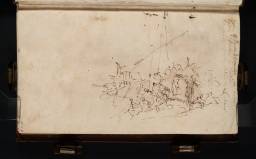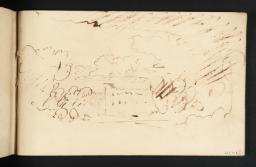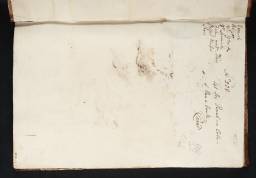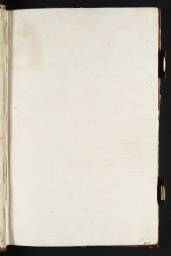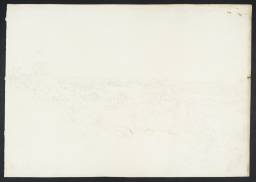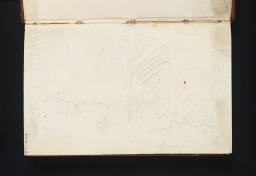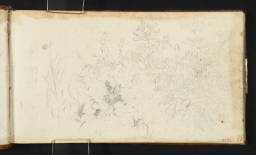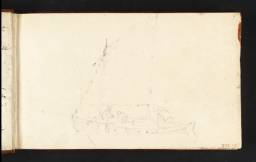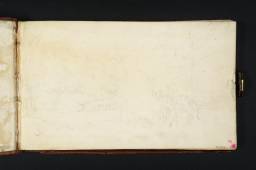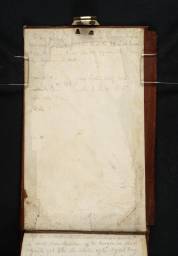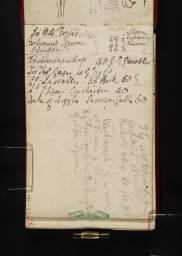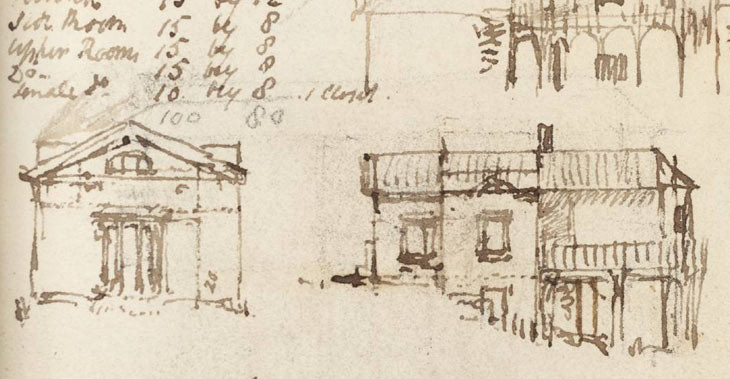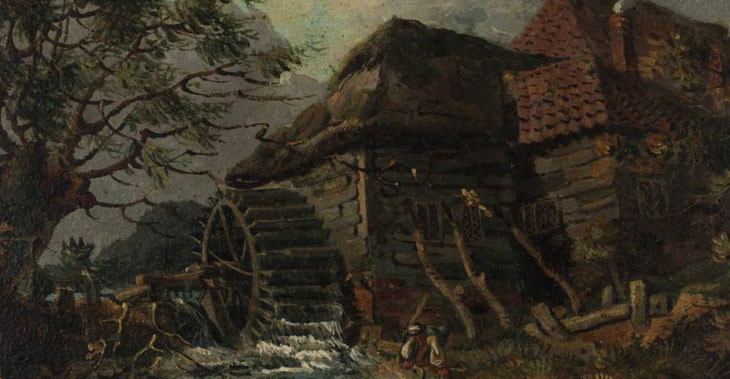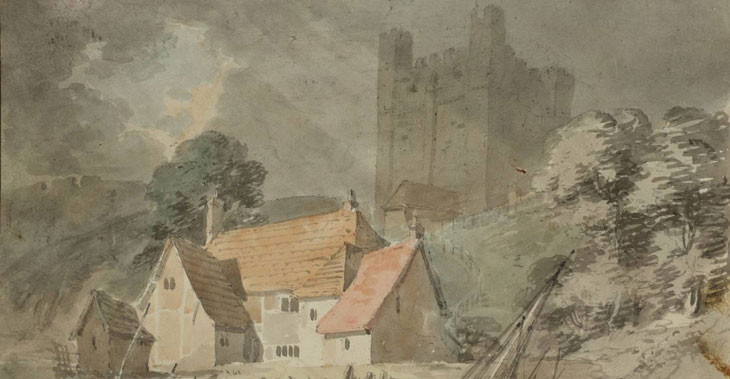Sketchbooks used at Isleworth, Hammersmith and along the River Thames c.1804–14
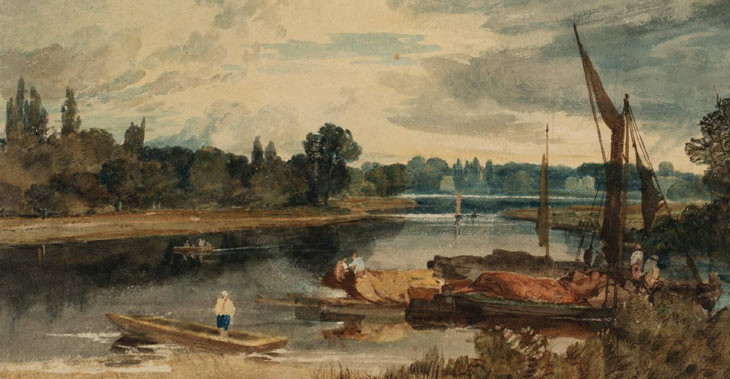
The River Thames near Isleworth: Punt and Barges in the Foreground 1805
(from the Thames, from Reading to Walton sketchbook)
From the entry
These sketchbooks associated with the River Thames are mainly datable to or from 1805 to perhaps as late as 1814. They depict the river from near Oxford through London to the Estuary, in various moods of weather, observed with vivid naturalism or transformed into visions of antiquity peopled with figures from history or myth. They are also linked by other interests and activities. Leaving aside the minor Eclipse and Composition Studies sketchbooks, the subsequent five books listed here have received most critical attention, especially from David Hill whose 1993 book provided many new identifications of subjects depicted and made an ambitious attempt to order (or even rearrange) their contents in a sequence following the itinerary of tours of the Thames and the Wey and Godalming Navigations in 1805 when Turner was renting Sion Ferry House at Isleworth. Hill constructed an engaging but sometimes conjectural narrative around ‘river journeys in the year 1805’. Not all these ‘Isleworth ...
Studies for Pictures: Isleworth sketchbook circa 1804–7
D05491–D05617; D40568–D40574; D41505
Turner Bequest XC
D05491–D05617; D40568–D40574; D41505
Turner Bequest XC
Thames from Reading to Walton sketchbook 1805
D05905–D05953; D40274; D40344–D40345; D40382
Turner Bequest XCV
D05905–D05953; D40274; D40344–D40345; D40382
Turner Bequest XCV
Hesperides (1) sketchbook circa 1805–8
D05766–D05842; D05844; D40632; D40634–D40636
Turner Bequest XCIII
D05766–D05842; D05844; D40632; D40634–D40636
Turner Bequest XCIII
River and Margate sketchbook circa 1805–9
D06363–D06491; D06493–D06517; D17159; D40596–D40602
Turner Bequest XCIX
D06363–D06491; D06493–D06517; D17159; D40596–D40602
Turner Bequest XCIX
References
These sketchbooks associated with the River Thames are mainly datable to or from 1805 to perhaps as late as 1814. They depict the river from near Oxford through London to the Estuary, in various moods of weather, observed with vivid naturalism or transformed into visions of antiquity peopled with figures from history or myth. They are also linked by other interests and activities.
Leaving aside the minor Eclipse and Composition Studies sketchbooks, the subsequent five books listed here have received most critical attention, especially from David Hill whose 1993 book provided many new identifications of subjects depicted and made an ambitious attempt to order (or even rearrange) their contents in a sequence following the itinerary of tours of the Thames and the Wey and Godalming Navigations in 1805 when Turner was renting Sion Ferry House at Isleworth. Hill constructed an engaging but sometimes conjectural narrative around ‘river journeys in the year 1805’. Not all these ‘Isleworth sketchbooks’ can be dated solely or exactly to that year while the others seem to have been used over several years afterwards, as might be expected from Turner’s regular visits to his out-of-town homes at Isleworth and Hammersmith. Since there is good evidence in these books and elsewhere that Turner owned a boat, he had plenty of opportunity to sail on the Thames. This catalogue concentrates more on locations of individual subjects than on reconstructing specific itineraries and errs on the side of caution in the matter of dating, generally giving broad rather than narrow ranges of date.
From late in 1804, when he leased Sion Ferry House until 1826 when he sold Sandycombe Lodge at Twickenham, Turner maintained second homes near the Thames where he could paint, read, rest and fish. His visits were most frequent during the first decade. Evidently, his motives were a mixture of the aesthetic, sentimental, personal and practical. In 1809 it was recorded that ‘Turner has said that a landscape painter may find sufficient scope for his pencil by studying the scenery on the banks of the Thames’1 and he told his colleague William Etty that ‘There is finer scenery on its banks than on any river in Italy’.2 Of his time at Sandycombe Lodge, he ‘lived at Twickenham, he affected to say – that he might live in sight of Sir Joshua’s house upon the hill’.3 This referred to Wick House, the residence of the painter Sir Joshua Reynolds on Richmond Hill, and the cultural associations of the Thames west of London, embracing the poets Alexander Pope at Twickenham and James Thomson at Richmond and Hammersmith, were strongly felt. A more immediate attraction for Turner must have been the arrival of his friend Henry Scott Trimmer as vicar of Heston, Middlesex, in August 1804. Further away but still accessible at Ealing, another close friend, the architect John Soane, had built his own escape, Pitzhanger Manor. According to Joseph Farington, Turner hoped to save money by spending time out of central London. On 10 May 1806, he reported that ‘Turner is going to reside abt. 10 or 12 miles from London, & proposes only to retain in London His Exhibition Gallery. This He does from an Oeconomical motive’.4 In 1804, there had also been an expected French invasion, with its likely impact on the capital, to worry about.
Sion (or Syon) Ferry House was rented in 1804 and used during the summer of 1805 and part of the following year.5 Turner wrote his name and new address inside the cover of the Studies for Pictures: Isleworth sketchbook and painted the house in the Thames from Reading to Walton sketchbook (D05952; Turner Bequest XCV 48). These books were among the five used during his time there. In the first, the mixture of nature studies and classical and historical compositions is rooted in scenery at Isleworth and Syon, where Robert Mylne’s waterside Pavilion at the corner of Syon Park lent an ideal tone to the landscape. Variously transformed, sometimes as part of the architecture of ancient seaports like Carthage, it appears in many views, for example in a fascinating series in the Wey, Guildford sketchbook in which the riverside is progressively romanticised or historicised with the addition of mountains and triremes (D06195–D06198; Turner Bequest XCVIII 11–14). Trimmer’s frequent company, whether on fishing trips along the river or as unofficial tutor in the classics in return for drawing lessons, probably accounts for the many ideas for subjects from Plutarch, Homer, Virgil or Ovid taking shape in Turner’s mind.
The two Hesperides sketchbooks contain a similar blend of nature and the ideal but also range further afield from Turner’s base at Sion Ferry House. Hesperides (1) has views as far up-river as Abingdon, and in the opposite direction in the City of London and the Estuary perhaps made later in 1805 or the following year. Views of the maritime Thames in this and other sketchbooks are not always easy to date. In the winter of 1805–6, Turner travelled down-river to see the Victory when she returned after the Battle of Trafalgar and Andrew Kennedy also traces the origin of his pictures of the Estuary and Sheerness exhibited from 1807 to 1809 to this trip.6 But while it might account for some of Turner’s sketches, it is arguable that he would have been in too much of a hurry to catch Victory when she arrived, and then to get back to his studio with all the drawings he had made of her, to do much other work – let alone make the rather elaborate or coloured drawings of the Pool of London in Hesperides (1) (for example D05785; Turner Bequest XCIII 12). In this writer’s opinion they are later, along with studies of rustic life that seem to be connected with a visit to Cassiobury Park near Watford at harvest-time in 1807.
Another trip that emerges from the Isleworth sketchbooks is one up the Thames to Oxford. Hesperides (2) portrays scenery towards the city. Turner presumably used his boat for this expedition which Hill dates, convincingly, to September or October 1805. If Turner set off at the beginning of September, it may have been partly to meet Soane at Pangbourne for some trout-fishing, as recently mooted by Gillian Darley.7 Soane knew the area well, having been born at Goring, and he and Turner seem to have gone together to Reading and Pangbourne with Timothy Tyrrell, the Remembrancer of the City of London.8 Leaves from the dismembered Thames from Reading to Walton sketchbook record parts of this trip. Probably earlier the same summer, Turner took his boat on a shorter trip to Windsor and made a diversionary tour of the Wey and Guildford Navigations, using the Wey, Guildford sketchbook en route. Its views of Windsor, Godalming and Guildford are juxtaposed with typical Isleworth ideas for subjects from Homer and Virgil. That it contains both the origin of Windsor Castle from the Thames (Tate T03870; displayed at Petworth House)9 and probably Turner’s first idea for Ulysses Deriding Polyphemus – Homer’s Odyssey (National Gallery, London),10 exhibited in 1829 (D06351, D06350, D41507, D06186; Turner Bequest XCVIII 133–132a, 4a–5), gives an idea of its range.
While the classical-historical subjects in these sketchbooks are evidence of Turner’s wide reading and provided a fund of material for pictures, the many studies from nature have proved most attractive to modern eyes. Combined with oil sketches on wood panel and canvas from the Turner Bequest whose subjects dovetail closely with them, they recall the unusually changeable weather during the summer of 1805 – wet, stormy and cool in the earlier months, improving from August but with a delayed harvest. Watercolours in Hesperides (1) and from the Thames from Reading to Walton sketchbook are particularly beautiful. Anticipating these and (perhaps optimistically in view of the prevailing weather) preparing for glare as he worked outdoors, Turner gave the leaves of the former book a preliminary wash of grey. In fact, they were used more often to depict lowering clouds or an occasional rainbow than brilliant sunshine. Of these two groups of works, they seem the freshest and most spontaneous while in design at least, those from the larger Thames from Reading to Walton book are more poised. It may be significant that they are on unprepared white paper, although it cannot be seriously doubted that most of these too were made in the open air. Sometimes, Turner may have had partial shelter or shade, on his boat or in the summerhouse built into the garden wall of Sion Ferry House.
Collectively, the watercolours and related oils made in 1805 are part of a wider story of naturalism in the first decade of the century in which the rustic Thames played a leading part. Turner probably knew little and cared less for John Constable’s endeavours to find a ‘natural painture’ on the Suffolk-Essex border from 1802 but William Delamotte, an acquaintance from at least 1800 and now a drawing master at the Military College at Great Marlow, painted oil sketches from nature by the Thames in 1805. From a base at Reading, William Havell was also an active outdoor sketcher in oil and watercolour. At Twickenham during the summer of 1806, Turner could hardly have been unaware of the activities of John Varley who had taken a house there ‘near to the river’ as a base for his pupils’ outdoor sketching expeditions, when they followed his motto, ‘Go to Nature for everything’.11 Among them were John Linnell, aged fourteen in 1806, and William Henry Hunt, then sixteen. Their Twickenham sketches are often in oil, but Varley was a watercolourist and surely encouraged open-air work in that media as well.
Leaving Sion Ferry House some time in 1806, Turner took another property, 6 West End, off Hammersmith Terrace. Again, the address is written in a sketchbook, the River, mainly datable to 1807. Along with views of the Thames around Twickenham, Walton and Laleham this contains the drawing (D06015; Turner Bequest XCVI 45) for Pope’s Villa at Twickenham, during its Dilapidation (on the London art market in 2008).12 The demolition of the poet Alexander Pope’s house by Baroness Howe in 1807 was an act of cultural sacrilege that affected Turner deeply and resonates through his sketchbooks for years, especially in passages of his own verse in which he tried to do justice to the catastrophe and to Pope’s memory. There are many in this sketchbook alone. Also in the book are views of Cassiobury from the 1807 visit, and others of the Grand Union Canal, suggesting that Turner went there by canal from Brentford. On the same trip, he drew the germ (D06071; Turner Bequest XCVI 76 [actually folio 49]) of his later watercolour More Park, near Watford, from the River Colne (Tate D18141; Turner Bequest CCVIII H).
Overlapping with the River sketchbook is another, Windsor and Eton, used in 1806 or later. Drafts of verses (D06164, D06165; Turner Bequest 83, 83a) associated with The Goddess of Discord Choosing the Apple of Contention in the Garden of the Hesperides (Tate N00477)13 exhibited at the British Institution in 1806 might argue for some use of the book at Sion Ferry House. However, these were not published when the picture was shown and may be later. The book must have been used mostly at Hammersmith, as proposed by Hill. Views of Windsor and surroundings and sketches of field workers and ploughing are probably not from the 1805 trip but later, and connected with Ploughing up Turnips near Windsor (Tate N00486)14 exhibited at Turner’s Gallery in 1809. Turner left the Hammersmith house by late in 1811 but his visits had probably petered out earlier owing to disturbance from the construction of the West Middlesex Water Works right behind it.15 The sketchbooks certainly suggest a diminishing exposure to scenery west of London and more interest in the Thames to the east of the capital and along the Estuary.
When Turner made the trip down the Thames as far as Margate and also into the River Medway recorded in the River and Margate sketchbook is unclear. If this tour was an extension of his trip to see the Victory at the turn of 1805–6, its impact on his output of pictures was delayed. The book must have been used for marine pictures like Confluence of the Thames and Medway (Tate T03874; displayed at Petworth House)16 exhibited at his Gallery in 1808 and there are certainly drawings (for example D06486; Turner Bequest XCIX 73 [actually folio 77]) for a picture shown at the Royal Academy that year, The Unpaid Bill, or the Dentist Reproving his Son’s Prodigality (the Schindler Family).17 These figure studies for a comic-genre composition based on seventeenth-century Dutch painting and commissioned by a leading collector and arbiter of taste, Richard Payne Knight, are a world away from the quick sketches of Essex and Kent shore in this book. So too is Turner’s note inside the cover (D40597) testing out a response to a complaint in The Examiner of 8 January 1809 about Soane’s failure to deliver his lectures as Professor of Architecture, and by implication his own as Professor of Perspective, at the Royal Academy.
Turner’s protracted preparations for the lectures, his ambitions for them but also his self-doubt, had hung over him since his appointment in December 1807. He drew attention to the post by adding the initials ‘P.P.’ to his signature on both Pope’s Villa and London (Tate N00483)18, exhibited at his Gallery in 1809, but did not actually lecture until 1811. His research and note-taking and a draft request for a further postponement (D06764; Turner Bequest CII 23) join an intriguing mix of overlapping concerns in the Greenwich sketchbook. At its heart are sketches (for example D06813–D06814; Turner Bequest CII 47a–48) and verse (D06728; Turner Bequest CII 4a) associated with London. There is also a drawing inside the cover (D40667) for Shoeburyness Fisherman Hailing a Whitstable Hoy (National Gallery of Canada, Ottawa)19 shown at the same time and later taken by Walter Fawkes in exchange for London which he returned to the artist. A number of Fawkes’s commissions and purchases of watercolours by Turner are listed (D06824; Turner Bequest CII 53 and D40668), with much interesting information.
The Greenwich book is rich in Turner’s verse. There are further reflections on the destruction of Pope’s villa including drafts (D06740–D06743; Turner Bequest CII 10 a–12) of an ‘Invocation of Thames to the Seasons – upon the Demolition of Pope’s House’, in which Turner also refers to James Thomson, author of The Seasons (1730) while in lodgings at Hammersmith and Pope’s near-neighbour at Richmond. Mention of his ‘Shrine’ and poetic lyre connects with Thomson’s Aeolian Harp (Manchester Art Gallery),20 exhibited at Turner’s Gallery in 1809. Even more than Pope whose Augustan cultural values he shared and whom Turner called a ‘British Maro’ or Virgil, Thomson represented a line of descent from a pastoral tradition reaching back to the Roman poet, whose Eclogues Turner tried to read in Latin, perhaps under Trimmer’s instruction. For Turner, the Thames was Britain’s national river, a microcosm not only of scenery but of history and culture too. Inspired by Thomson’s patriotism (as the author of ‘Rule Britannia’) his imagination follows the river to the sea to muse on maritime exploration and trade as the foundation of national wealth and pride. Historically, Turner becomes preoccupied (D06772, D06732; Turner Bequest CII 1a, 6a) with the efforts of the explorer Hugh Willoughby to find a North-East Passage to China and India and his tragic death in 1553, while observation of commercial traffic on the modern Thames is at the heart of his picture of London and his verses for it.
The last sketchbook in this group, Boats, Ice, has further sketches of activity on the Thames, and passages of verse (D06709; Turner Bequest CI 85a to inside back cover, D06618) on the demolition of Pope’s villa that are more advanced than those in the River sketchbook but presumably roughly contemporary. The drawings of ice-bound boats and ships for which Turner named the book pose something of a conundrum, not least in respect of their date. While some writers assume that they record the frozen Thames as witnessed perhaps from Turner’s house at Hammersmith,21 the only (and last) frost to produce conditions as bad as depicted was in 1814, by which time Turner had given up the house. And while some drawings could be of the river, others (Tate D06636, D06637; Turner Bequest CI 17, 18) appear to show larger ships in peaks of ice almost amounting to icebergs. Not for nothing did John Ruskin describe the second of these as ‘The Inscrutable!’ Perhaps they are visualisations of Willoughby’s demise, complementing Turner’s verses in the Greenwich sketchbook.
By the time Turner moved out of the rented Hammersmith house, he was beginning to plan a new house of his own on land at Twickenham bought four years before. Material related to the future Sandycombe Lodge, individual drawings or watercolours and later sketchbooks with Thames scenery are all treated separately in this catalogue.
Note: Subsequent research led to the inclusion in 2016 of the Composition Studies sketchbook (Turner Bequest LXV 1–30), formerly dated to about 1801, in the present section. In 2023, it was joined by the largely blank Eclipse sketchbook (LXXXV 1–100), apparently used only briefly to record an unspectacular partial solar eclipse on 11 February 1804, likely viewed in the London area. The original text of this Introduction remains otherwise unchanged.
Rates were last paid on it on 15 May 1806 and it was standing empty by 30 October; Hill 1993, p.173 note 6; James Hamilton, ‘Sion, or Syon, Ferry House, Isleworth’, in Oxford Companion, p.294.
Helen Dorey, John Soane & J.M.W. Turner: Illuminating a Friendship, exhibition catalogue, Sir John Soane’s Museum, London 2007, p.9.
How to cite
David Blayney Brown, ‘Sketchbooks used at Isleworth, Hammersmith and along the River Thames c.1804–14’, December 2009, revised by Matthew Imms, November 2023, in David Blayney Brown (ed.), J.M.W. Turner: Sketchbooks, Drawings and Watercolours, Tate Research Publication, December 2012, https://www


